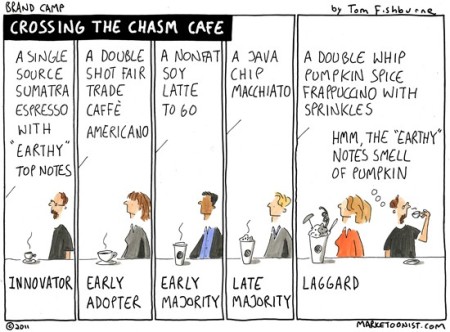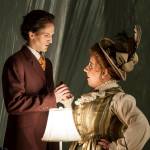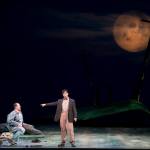Musicals at the opera house?
The following blog entry started out as a comment on a Facebook post by Tulsa Opera, asking the question “What do you think about opera companies producing musicals.” A link is at the bottom.
 The most concise answer I have ever heard to the ongoingly and often fiercely debated question “what’s the difference between opera and musicals” was this: “If it makes money, it’s a musical. If it loses money, it’s an opera.” Beyond the humor, this clever aphorism reveals an important truth: the difference between opera and musical theater is more an economic one than artistic. It has to do with the business of producing shows and the nature of the value generated through art in each case.
The most concise answer I have ever heard to the ongoingly and often fiercely debated question “what’s the difference between opera and musicals” was this: “If it makes money, it’s a musical. If it loses money, it’s an opera.” Beyond the humor, this clever aphorism reveals an important truth: the difference between opera and musical theater is more an economic one than artistic. It has to do with the business of producing shows and the nature of the value generated through art in each case.
In the US, operas are virtually always produced by non-profit organizations, while the majority of professional productions of musicals are presented by commercial corporations. A commercial corporation aims to generate enough ticket sales to recoup its costs and make a profit. A non-profit opera company typically earns less than 50% of its budget from ticket sales, and the rest is covered by private and public donations.
This leads to two conclusions:
-There is enough demand for musicals to make money from ticket sales, but there is not as much demand for opera.
-In spite of the insufficient demand, society apparently deems opera, as well as symphonic music, ballet, certain types of theater etc. necessary and beneficial enough to grant them an economic advantage, a “leg up” on the competition.
These conclusions do not speak to the intrinsic value of the art itself, but give us a clue of how the two types of producing organizations use art to generate economic value, and therefore what should guide their choices.
The ultimate purpose of all art is to illuminate the human experience (in addition to entertaining, of course) and both musicals and opera achieve that to some degree. Non-profits, however, in return for the economic advantage they receive from the state, have additional responsibilities. In the case of opera companies, that responsibility is to take the quest for artistic meaning and depth beyond the limits of commercial theater.
With all this in mind, I would propose that the frequently asked question “Should opera companies produce musicals” might be best broken down into some more specific components, such as “Which opera companies should produce musicals, when, how and why?”
WHICH: Not all opera companies are the same. Large international companies like ENO, the Met or the Chicago Lyric have very little in common with regional US companies, and therefore the latter should be very careful in trying to emulate the former. While all opera companies, large and small, aim at success through generating excitement, the big companies are able to invest up front in lavish productions, big name singers and state of the art marketing campaigns, which though they don’t guarantee artistic success or full houses, they nevertheless give blockbuster companies an initial boost, and can make the venture look like a success even when it’s not. For cash-strapped regional companies, even licensing fees alone for a Sondheim or an R&H title can be a daunting budget item, not to mention all the other production and technical requirements that come with some of the larger musicals.
WHEN: The Lyric Opera of Chicago, which is in the fourth year of what appears to be a successful R&H initiative, is doing the musicals outside its main season. The Lyric’s eight regular productions have remained squarely within “opera territory” with the musical as an add-on. Central City Opera, on the other hand, which included a musical in its mainstage season, abandoned its initiative after two seasons, which may suggest that its strategic objectives (presumably ticket revenue, new attendees etc) were not met. In the case of a regional company that only produces three or four titles per season, taking up one slot with a musical can be a turn-off to the dwindling but important contingency of subscribers and opera lovers, who might not see the point of going to the opera for a show that is typically available in touring productions, on TV, or even a local high school.
HOW: Many of the core capabilities required in musicals (sound design, extensive dialogue, triple-threat performers etc.) are not built in to opera companies, since opera typically focuses on the appeal of super-human voices and superb musical values. Producing a musical is undoubtedly an extremely valuable learning experience for an opera company, but can also be strenuous, costly, and may result in shows that are underwhelming compared to those produced by a Broadway company.
WHY: Going back to the idea of artistic mission, an opera company’s goal should be to present a season that constitutes a unique, authentic and compelling artistic proposition, which of course should be also fiscally responsible and market-oriented. If a case can be made for Sondheim, R&H, L&L, Loesser, or even Lloyd Weber having a place in such a season, then by all means yes! If, however, the idea to include a musical in the season is simply motivated by “Well, Rigoletto didn’t sell, let’s try The Sound of Music” then not only is the artistic proposition weak, but it entails significant financial risks.
What do you think about opera companies producing musicals?
Posted by Tulsa Opera on Friday, March 25, 2016
8 REASONS WHY I PROGRAM AMERICAN OPERAS
2015-16 marks the fifth season in a row in which Tulsa Opera includes an American opera in its mainstage programming. This is not as rare an occurrence as it was even ten years ago, but it’s still far from the norm at regional American companies. Although companies like the Minnesota Opera, the Florentine, Nashville Opera, and several others have an impressive record of producing American works, often in world premieres, many still consider American opera the territory of major international companies like San Francisco, Santa Fe and Houston. (On a side note, the Met’s 2015-16 season includes no American work, and with the exception of Lulu (1937) nothing more recent than Puccini.)
In Tulsa I have been fortunate to be supported by a Board and staff who recognize the vitality of American opera and have backed my programming choices starting with Dead Man Walking in 2012. There are many other visionary opera boards and executives at regional companies who chose to lead rather than follow with their programming. Still, and paradoxically, American opera is a hard sell in America. New works of American grand opera (as opposed to chamber opera) generally cost more to produce, are labor-intensive for Production and Marketing, and don’t bring in the ticket revenue that Puccini often -though not always- does.
In light of those difficulties, it is understandable that even some of the most courageous opera executives and Boards occasionally get cold feet when they look at the numbers. As the Artistic Director of a mid-size regional opera company myself, I deal every day with questions of how to balance artistic vision with financial reality; the investment in the future with the necessity of today; the need to bring in new audiences with the need to hold on to long-time patrons. The question of how American opera fits into the company’s present and future is often the topic of discussion with patrons, donors, Board members and colleagues.
Every single day I ask myself if I am wrong to want to include American or other contemporary opera in every Tulsa Opera mainstage season, especially as I am limited not only by finances and the availability of physical productions, but also but my own sense of which works are relevant and can appeal to my audience. After several years of preoccupation with both the artistic and business/financial implications of the subject, I have been able to put into words what it is that makes me so convinced that American opera is an essential part of a regional American company’s season. I am sharing those here with you and look forward to your feedback and comments.
-

Peter Strummer, Elizabeth Fischborn, Keith Phares, Stefan Barner and chorus in Aldridge and Garfein’s “Elmer Gantry”
Contemporary opera is at this point mostly an American affair. Not only are there more new operas being written in the US than in any other country in the world, but the vast majority of these new operas are written with mainstream audiences in mind. Opera is now a US native art. It draws on the nation’s history, literature and culture, and speaks in recognizably American musical terms about the American experience. American composers are showing the way to the future of opera. Shouldn’t we “Buy American” once a year?
- We can’t make the argument that opera is alive if the most recent work in our season is 150 years old. There has been a lot of discussion in media and blogs in recent years about whether “opera is dying.” After a few decades of relatively easy wins during which La Boheme paid the bills, the warhorses are no longer the guarantee they used to be. At the same time, it’s becoming more and more difficult to explain why anyone should go to the opera, or donate to it. In this discussion I like to be able to show proof that opera is not a museum item, but a vital proposition in contemporary culture. That proof is that artists want to create it and people come to see it.
- Some people will never buy a ticket to a 150-year old show sung in a foreign language. That doesn’t mean they shouldn’t come to the opera. Verdi is one of my favorite composers, and I often struggle to understand why some people just aren’t interested in a great production of La Traviata, or A Masked Ball. Then I remember that recent generations of Americans have grown up without a love and understanding for the legacy arts. Opera for them is that old Italian stuff that grandma likes. Powerful and entertaining shows about familiar subject matter, told in great music, and sung in their own language will bring them in. They do bring them in. Slowly.
- Contemporary American opera typically is powerful drama. Opera is many things, but above all, it is theater. That is the attribute that best qualifies it to compete in today’s culture, which has been defined by the dominant influence of cinema. Theater was very different two hundred years ago. Bellini’s music is sublime, but his operas are not great theater today. When stage directors bravely try to bring modern dramatic sensibilities to the works of Verdi, Donizetti, or Gounod, results are often mixed. Contemporary operas are written for movie-watching audiences by movie-watching composers, and offer an inherently visceral, fast-paced opera experience which debunks the stereotype of voluptuous ladies in horned helmets shouting from the footlights.
- Placing contemporary works and classics side by side in a season is in itself a dynamic artistic proposition. Works of art, including operas, do not only relate to the audience. They also relate to one another. All operas were new at one time, and the best of them were bold and controversial when they were new. After hearing a new work we always end up discussing its meaning and value. That discussion deepens our understanding not only of the work in question, but of the art form as a whole. The effort to understand the new inevitably casts new light on the old.
- The core audience is not the only audience. Resistance to contemporary programming often comes from long-time, valued patrons. These are people who have bought tickets and made donations for years. Many of them are part of the 20% that provides 80% of the revenue, and most of them genuinely care for the company. We should listen to them, respect them, give them what they want as often as possible, thank them profusely, and keep them engaged. However, if we focus on serving those patrons only, we won’t be around long. Remember Blockbuster? They went out of business while striving to serve their core customers.
- Artists are as important to an arts organization as donors and ticket buyers. It is true that without donations and ticket income we won’t have opera companies. It is also true that without vibrant artistic propositions opera companies won’t be worth having. The driving force behind art is the artist’s vision and desire to create. Innovative programming is exciting to artists, and engaged and excited artists make better art and serve communities better.
- Contact with the arts should be a transformation. Not a transaction. There’s a reason arts organizations are non-profits. Long time ago it was decided that art is necessary in our communities and should exist, although it can’t always compete in the free market. In exchange for the economic advantage that society gave us, it expects us to enlighten, inspire, educate, challenge, innovate, experiment, and make transformative experiences available to our communities. Although you can buy a ticket to an opera, it would be misunderstanding the function of art to view the opera house as a luxury tunes store, which should only stock what sells.
Adaptors and Innovators in opera.

[The thoughts below came to me while listening to “Lecture 3: Creative Styles” of “The Creative Thinker’s Toolkit,” an audio course on Creative Problem Solving by The Great Courses.]
Most people speak about creativity as a gift that nature bestows randomly upon a few select individuals. The truth is: all people are creative to some degree. We “creative types” have simply had more practice. Michael Kirton, Director/Founder of the Occupational Research Center, went one step further, showing that creativity is defined by style, as well as degree. In his book Adaptors and Innovators Kirton describes Adaption-Innovation as a cognitive style, a “preferred mode of tackling problems at all stages.” “Adaptors” are the people who work mostly within established norms, play by the rules, focus on details, and aim at doing things bettter. “Innovators” tend to “detach the problem from its cocoon of accepted thought,” to step “out of the box”, turn things on their head and aim at doing things differently.
Organizations need both types of creativity to succeed. Innovative creativity is most needed when a company is starting out, when it is in a crisis, but also to a more measured degree during the easy times in order to avoid stalling. Adaptive creativity gives new ideas strength and longevity, and is the primary driver of growth in stable and predictable environments.
The lecturer in my Great Course series put forward two great artists as exemplars of the two types of creativity: Norman Rockwell, who strove for idealized perfection, was an “adaptive” creator, while Pablo Picasso, the “bad boy” who challenged the established norms and helped change the way we look at painting, was an “innovator.” (Pop-quiz: where within that spectrum do you think Haydn, Beethoven, Verdi, Puccini, Stravinsky and Britten fall?)
The choice of terms is a little unfortunate, since “innovator” sounds more glamorous than “adaptor.” The fact remains that both Rockwell and Picasso were geniuses. Although history tends to elevate Innovators above Adaptors, we shouldn’t forget that in real time both types are equally indispensable.
The problem is that, since each one of us leans toward one side or the other, we tend to view the guys on the other side with suspicion: Innovators tend to be condescending to Adaptors and see them as stayed and unimaginative. Adaptors see Innovators as undisciplined, inconsiderate and, well, crazy. When an organization is in any kind of crisis, each side sees the other’s approach as the problem.
In my world, the world of regional opera in the US, the tug-of-war between adaptation and innovation plays out in the repertoire discussion. Boheme or Nixon in China? Artists, administrators and patrons are all creative thinkers-even if the “creative” label is typically attached to the artists-and we are all trying to solve one problem: attendance. Adaptors insist that the established norm, traditional repertoire, is the solution, if only we can improve, optimize and repackage it. Innovators think that shaking things up with new, unfamiliar, ground-breaking programming is the way to go.
The truth is somewhere in between.
Our operating environment, contemporary American culture, society and economy, is volatile. The performing arts are not an automatic draw. “Business as usual” is not working. It’s time for innovation, so Adaptors have to suspend judgement and give the bad boys and girls a chance. They should also put their own irreplaceable ability to improve, perfect and proliferate at the service of new ideas. Innovators have to be patient. This is not a “go big or go home” time, nor should we throw the baby out with the bath water. Nourishment comes from the roots, and unless they get the Adaptors to work with them, their fancy new ideas will be short-lived.
It’s time to learn how to talk to each other.
Are we listening with our ears or our eyes?
On May 19, 2014, this review of a production of Der Rosenkavalier, Glyndebourne, East Sussex, UK-review appeared in the Financial Times, prompting an international avalanche of protest and kindling a critical discussion about the relevance of singers’ physique to the operatic art form. Below are some of my thoughts on the topic.
Most of Opera’s perception problems we have brought onto ourselves. For too long we have ridden the coattails of the entertainment industry and promoted opera on terms which are not sustainable.
Marketing professionals, and often we, Artistic and General Directors, more anxious to sell a ticket now than to sell ten tickets ten years from now, promote opera on whatever we can grab onto: Name recognition, popular tunes, fancy scenery, directorial “concepts” and, as of the last ten years or so, singers with movie star looks and ballet dancer bodies.
Sexy-looking girl on the brochure? Always.
Baritone with his shirt off on the poster? You bet.
Gratuitous sex and nudity on stage? Yeah baby.
Can you blame the public for thinking that’s what it’s about?
I have no solution. If we don’t sell tickets today we won’t be here in ten years. But if we want to help change things perhaps we should put a little less emphasis on the barihunks and talk a little more about what opera is really about: great stories, emotional intensity and deep humanity conveyed in music composed by geniuses and performed by super-humans.
The only problem is that to get the effect you must have an open mind and be able to focus on something other than yourself for a couple of hours . And, unfortunately, open minds and focus are not the zeitgeist.
Edgar Allan Poe in Fargo, ND
Hello from Fargo, North Dakota! What am I doing here? Spring came to Tulsa a little too early this year so I decided to head north and enjoy some more winter.
No, seriously: I’m here conducting the world premiere of The Poe Project at Fargo-Moorhead Opera.
What?
Yes, Fargo, ND has an opera company. It is run by a Tulsan, the tenor David Hamilton who has been on the faculty at Concordia College for the last twenty years. Fargo-Moorhead Opera stages two operas each season, with a professional orchestra and chorus and with many of the same wonderful singers that you can hear on stages across the United States.
The Poe Project was created under the auspices of the American Lyric Theater, Larry Edelson’s New York-based nursery for new American works. Remember when the Tulsa Opera Studio Artists performed All Wounds Bleed at the Philbrook last year? That’s another ALT work.
The Poe Project consists of two one-acts, each about an hour long, which tell contemporary horror stories. In Buried Alive, the painter Victor Moreno is visited by a sexy female mortician who tells him that he is dead and he has to choose between burial and cremation. Victor’ wife, Elena, tells Victor that this is nonsense, and he always acts strangely when he is on the verge of a major artistic breakthrough. Well, it turns out she is wrong.
Or is she?
In Embedded, star news anchor Sylvia Malow feels that her career is sinking as her younger rival, Victoria, is becoming popular with the producer and the TV audience. She ends up drowning when she accepts the invitation to an exclusive interview with a notorious terrorist and gets caught in the Holland Tunnel is bombed on both sides by said terrorist.
But not before she can broadcast her own death on a live video phone feed.
That’s the face of new opera, folks: video phones, TV anchors and angsty New York artists. The music, by Jeff Myers and Patrick Soluri is haunting, inventive and quirky. There is a singing GPS and an “embalming trio” worthy of CSI. David Hamilton has assembled an amazingly talented cast of young singing actors who could hold their own on prime time TV. The production is hi-tech with video and lighting effects for the 21st century.
We had two orchestra rehearsals yesterday, with the composers present (!) and we move into the theater tonight. Opening on Friday and matinee on Sunday. Opera is alive and well in Fargo, ND. Join me?
For more info on the show check this out:
What would Poe do? Fargo-Moorhead Opera scares up world premiere.
Kostis



